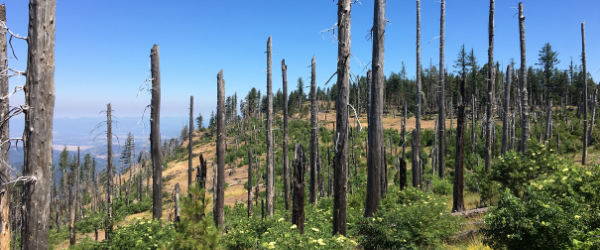
We need your help to stop a disastrous proposal from President Trump’s Bureau of Land Management. These proposed new loopholes would undermine environmental laws and public participation, making it easier to “get out the cut” on vulnerable public lands after fire and other natural disturbance events.
Unfortunately, this action isn’t as simple as just clicking to send a letter. Comments need to be submitted through the BLM’s official website, which is not difficult. We’ll walk you through it with these instructions here, as well as a sample letter that you can edit to make your own. Below that, you’ll find some background detailing how important post-fire landscapes are, and how destructive the BLM’s plans would be.
SAMPLE LETTER |
|
Dear BLM: I strongly urge BLM to reject the proposal to exempt salvage logging from environmental review and informed public comment. The proposal to authorize a new and expanded salvage CX would allow up to 5,000 acres of logging without the thoughtful consideration required by NEPA. I urge BLM to do LESS logging after fire and other natural disturbances, not more. Natural disturbance is what makes our public forests complex, diverse, and unique. Virtually every old growth forest that the public knows and loves has been affected by fire and other disturbances, and they would not be the same if they had been logged afterward. Salvage logging and associated road building will cause significant effects on the environment and deserves careful site-specific environmental review to inform the decision-maker and the public - not a quick rubber stamp without adequate review. Salvage logging increases the widespread shortage of large snags and down wood that are valuable for fish, wildlife, climate stability, soil and water conservation, and complex forest development. Removing large wood, combined with replanting conifers after salvage logging will increase fire hazard and exacerbate the shortage of complex early seral forests, and increase the prevalence of simplified tree farms that are already over-abundant. Temporary road building is temporary in name only, and is likely to cause significant long-term impacts on soil, water quality and quantity, carbon storage, and weeds. The CX proposal is improper not only because the site-specific effects are likely to be significant, but also because BLM has never conducted a programmatic analysis of the cumulative effects of its agency-wide salvage logging program. I urge you to reject the proposed rule change. Sincerely, |
INSTRUCTIONS
You can help stop this aggressive old growth logging proposal by commenting on BLM’s rulemaking.
- Click and drag to select the sample letter. Press control-C to copy the selected text.
- Open this link (preferably in a new tab): https://eplanning.blm.gov/eplanning-ui/project/1504279/570/8001448/comment
- Paste the sample text in the big box labelled “Comment.” If possible, please edit and embellish the sample comment letter to make it your own. Consider using the ideas from the background narrative below.
- On that same page, scroll down to “Submitter(s)” and add your first and last name. Optionally click the check-box that says “I would like to provide additional contact information” which allows you to add your email and mailing address, add the name of any group that you represent, and add yourself to the mailing list for this project. (Again, other than your name, all that is optional.)
- Click “Preview” and on the next screen you can select a box to share or withhold your personal identifying information.
- Click “Submit and you’re done! Bonus points if you share this page with your friends!
The deadline to get these comments in is Thursday, July 2nd!
BACKGROUND
Forests are survivors. They evolved with natural disturbance and are naturally resilient to disturbances like fire, wind, insects, ice storms, etc. In fact, without those natural disturbances old growth forests would not be as complex and beautiful. Forests have all the building blocks they need to bounce back after disturbance.
When a few large trees die it makes room for their neighbors to stretch their wings, and a shaft of light hits the forest floor allowing diverse new plants to grow. When severe disturbance removes large patches of trees, it makes way for establishment of “complex early seral” forest that is just as biodiverse as old growth and even more rare. The presence of large snags and a few surviving “legacy trees” helps old growth species persist even in highly disturbed forests which you might think are inhospitable. Conifers will re-establish in time, but for several decades the forest will be home to a flush of wildflowers and nitrogen-fixing plants and an abundance of birds, amphibians, pollinators, small animals, and big game that thrive in disturbed forests. The snags and dead wood left after disturbance serve a wide variety of “ecosystem services” including fish and wildlife habitat, carbon storage, water storage, soil conservation, slope stability, nutrient retention, microclimate buffering, etc.
In short, a burned forest is still a complex ecosystem, while a disturbance that is salvage logged is an ecological wasteland resembling a clearcut.
Trump’s proposed rule would allow BLM to log up to 5,000 acres of forest on public lands (and build new, destructive roads to access the timber) without the need to prepare an environmental review to inform the decision-maker and the public. BLM would also be exempt from the requirement to receive and consider informed public comment on proposed salvage logging. This is known as a CX, or Categorical Exclusion from the requirements of the National Environmental Policy Act (NEPA). We need your help to protect forests that experience natural disturbance. These complex forests on public lands have survived many disturbance events in the past and they can survive many more, but not if they are clearcut and turned into tree farms.

